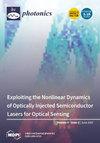通过准同步增益调制在 Er 型光纤激光器中产生静态高能量脉冲
IF 1.9
4区 物理与天体物理
Q2 OPTICS
引用次数: 0
摘要
我们展示了通过准同步增益调制在 ~1.5 µm 波长的掺铒光纤激光器中触发静态高能脉冲发生的可行性。这种简单的方法依赖于泵浦功率的正弦波调制,频率略高于激光腔中纵向模式的固有频率间隔。这种方法以前只在 ~1.1 µm 的掺镱光纤激光器中使用过。与掺镱光纤激光器不同,铒光纤激光器具有三电平激光能量图(在 0.98 µm 波长下泵送时),上电平激光持续时间很长(10 毫秒)。该方法的可行性在正常和反常腔内色散方面都得到了验证,而以前在 ~1.1 µm 波长的掺镱光纤激光器中没有这种色散。因此,在我们的试验台 Er 光纤激光器中,通过对 0.98 µm 的泵浦功率进行准同步正弦波调制,可以稳定地产生一列能量高达 180 nJ 的有规则的离散纳秒脉冲。我们的研究结果证明了这种经济可靠的方法在各种掺稀土光纤激光器中产生高能量脉冲的普遍适用性。本文章由计算机程序翻译,如有差异,请以英文原文为准。
Stationary High-Energy Pulse Generation in Er-Based Fiber Lasers via Quasi-Synchronous Gain Modulation
We demonstrate the feasibility of triggering stationary high-energy pulse generation in Er-doped fiber lasers at ~1.5 µm via quasi-synchronous gain modulation. This simple method relies upon the sine-wave modulation of pump power at a frequency slightly surpassing the intrinsic frequency spacing of longitudinal modes in the laser cavity. This was previously implemented only in Yb-doped fiber lasers at ~1.1 µm. Here, for the first time, we experimentally validate the pulse shaping capabilities of this method also in Er fiber lasers, which, unlike Yb fiber lasers, have a three-level laser energy diagram (when pumped at 0.98 µm) with a very long-lived (10 ms) upper laser level. The feasibility of the method was validated both for normal and anomalous intracavity dispersion, which was not available in previous implementations in Yb fiber lasers at ~1.1 µm. Thus, the stable generation of a regular train of discrete nanosecond pulses with an energy of up to 180 nJ was achieved in our test-bed Er fiber laser upon the quasi-synchronous sine-wave modulation of the pump power at 0.98 µm. The results of our study testify to the general applicability of this affordable and reliable method for high-energy pulse generation in various rare-earth-doped fiber lasers.
求助全文
通过发布文献求助,成功后即可免费获取论文全文。
去求助
来源期刊

Photonics
Physics and Astronomy-Instrumentation
CiteScore
2.60
自引率
20.80%
发文量
817
审稿时长
8 weeks
期刊介绍:
Photonics (ISSN 2304-6732) aims at a fast turn around time for peer-reviewing manuscripts and producing accepted articles. The online-only and open access nature of the journal will allow for a speedy and wide circulation of your research as well as review articles. We aim at establishing Photonics as a leading venue for publishing high impact fundamental research but also applications of optics and photonics. The journal particularly welcomes both theoretical (simulation) and experimental research. Our aim is to encourage scientists to publish their experimental and theoretical results in as much detail as possible. There is no restriction on the length of the papers. The full experimental details must be provided so that the results can be reproduced. Electronic files and software regarding the full details of the calculation and experimental procedure, if unable to be published in a normal way, can be deposited as supplementary material.
 求助内容:
求助内容: 应助结果提醒方式:
应助结果提醒方式:


